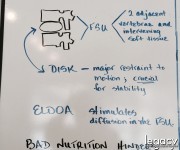The Functional Spinal Unit (FSU) as defined by Junghans includes the disco-vertebral body complex, the intervertebral foramen, zygopophyseal joints (the facet joints) and inter-laminar and interspinous spaces. The FSU also includes the related ligaments and muscles which maintain and move this segment.
All the parts create the whole. If any one of the functional parts does not work, the whole unit is compromised. There are many ligaments in the FSU that must all be in balance.
The FSU is the ‘motion segment’. There are two adjacent vertebrae and the intervening soft tissue or the disk. The disk is the major restraint to motion and it is crucial for spinal stability. If the disk loses height, bulges, or is herniated, stability is reduced and pain can result.
The ELDOA postures create space for the disk, helping it maintain its integrity.
Worth noting: bad nutrition hinders the effectiveness of the ELDOA. Additionally, hydration of the body means the disk is hydrated as well which is important for maintaining the space between the adjacent vertebrae. Proper ELDOA exercise, good nutrition and plenty of clean water is the recipe for spinal health.
